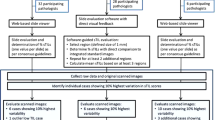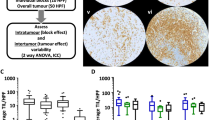Abstract
In this report, the Association of Directors of Anatomic and Surgical Pathology (ADASP) provides guidelines for the reporting of lymphoid neoplasms. The World Health Organization Classification of Tumors of the Haematopoietic and Lymphoid Tissues is the preferred international standard for diagnostic criteria (disease definition) and nomenclature. Ancillary studies are often required, and the Association recommends that immunophenotypic and genotypic information be integrated into the final report, to the extent possible.
Similar content being viewed by others
Main
The Association of Directors of Anatomic and Surgical Pathology (ADASP) has named several committees to develop recommendations regarding the content of the surgical pathology report for common malignant tumors. A committee of individuals with special interest and expertise write the recommendations, which are reviewed by the council of ADASP and subsequently by the entire membership.
The recommendations have been divided into the following four major areas: (1) items that provide an informative gross description; (2) additional diagnostic features that are recommended to be included in every report if possible; (3) optional features that may be included in the final report; and (4) a checklist.
Features the Association recommends to be included in the final report
Background Clinical Information
The Association recommends the inclusion of pertinent clinical history, when this information is available. The pathologist is encouraged to obtain clinical history, if possible. For some diseases, an accurate history may be essential to diagnosis, for example, post-transplant-associated lymphoproliferative disease.
-
1
Previous diagnosis of a lymphoid neoplasm, if known. Specify dates and site(s), and treatment status, if available.
-
2
Presence of generalized or localized lymphadenopathy.
-
3
Evidence of organomegaly (eg, hepatosplenomegaly).
-
4
Pertinent hematological findings (eg, lymphocytosis, pancytopenia).
-
5
Constitutional symptoms.
-
6
HIV status.
-
7
Prior immune abnormality, including congenital immune disorders.
-
8
Autoimmune disease.
-
9
Other pertinent serology (eg, HTLV-I, Epstein–Barr virus).
-
10
Other known cofactors, (eg, Helicobacter pylori infection).
Gross Description
The proper handling of the lymph node biopsy specimen is critical to ensure proper fixation, which is essential for the preparation of high-quality histological sections.1 The Association recommends that the pathologist receive lymph node biopsies fresh, intact, and that an unsectioned lymph node biopsy should never be immersed in fixative. It is recommended that each laboratory establish a protocol for the handling of lymph node biopsies that ensures both optimal histological sections and preservation of material for ancillary studies. These principles, and the procedures outlined below, also apply to extranodal sites that may be biopsied or resected for a potential diagnosis of lymphoma.
-
1
Identification: State how the specimen was identified: labeled with the patient's name, medical record number, organ or site.
-
2
State how the specimen was received (fresh, in fixative, intact vs sectioned).
-
3
State the surgical procedure used to procure the specimen (excisional biopsy vs incisional, vs core biopsy).
-
4
State the dimensions of the specimen.
-
5
State if there is a capsule, and if it is intact or altered grossly.
-
6
Describe the color and consistency (firm vs fleshy); presence of nodularity, necrosis, hemorrhage.
-
7
The Association recommends that lymph nodes be sectioned at 2 mm intervals, to ensure appropriate fixation.1
-
8
If the size of the lymph node permits it, it is preferable to cut sections perpendicular to the long axis of the lymph node. This orientation provides the greatest assessment of the architecture.
-
9
If the specimen is a spleen, provide the weight. Describe the appearance of any focal lesions (eg, infarcts, nodules, hemorrhage), and gross abnormalities of red or white pulp.
-
10
If the specimen is a spleen obtained for staging, the Association recommends that the spleen be sectioned at 3–5 mm intervals, to look for grossly identifiable lesions. First fixing thicker slices (1 cm) briefly in formalin may facilitate sectioning at the desired thickness. For staging laparotomy specimens for Hodgkin's lymphoma, the number of grossly identifiable lesions, if less than 10, should be stated. The presence of more than four nodules has been shown to be of prognostic significance.2
-
11
Unique identifiers should be used for each cassette, and the gross description should also specify the type of fixation used for each paraffin block.
-
12
It is often desirable to fix tissue in more than one fixative. Some fixatives provide excellent cytological detail (B5, B+), but compromise the ability to extract DNA for molecular studies. Formalin is most suitable if polymerase chain reaction (PCR) studies from the paraffin-embedded sections are anticipated.
-
13
Snap-freezing is useful for preserving tissue for frozen-section immunohistochemistry, or future molecular studies. The following is a suitable procedure.
-
a)
One or more blocks of fresh tissue approximately 1.0 × 1.0 × 0.3 cm3 are cut from the specimen.
-
b)
The tissue blocks are placed in a mold, cork or other suitable form and immersed in Optimal Cutting Temperature (OCT) (Sakura Tissue Tek; Torrance, CA, USA) embedding compound.
-
c)
A sludge is made of dry ice and isopentane (2-methyl butane) and the tissue and mold are immersed into the solution and snap-frozen.
-
d)
The blocks are labeled and stored at −80°C or over liquid nitrogen.
-
e)
Blocks in OCT are suitable for frozen-section immunohistochemistry and also can be used for molecular analyses. If there is sufficient tissue, blocks can be snap-frozen without OCT for molecular studies and held at –80°C or over liquid nitrogen until needed.
Diagnostic Information
-
1
Specify exact anatomic site, if known, and tissue (lymph node or other).
-
2
Specify procedure (excisional biopsy, incisional biopsy, needle core).
-
3
Histological tumor type. The Association recommends the use of the WHO classification of tumors of the hematopoietic and lymphoid tissues (Tables 1, 2, 3 and 4).3 The designation of morphologic or clinical variants is considered optional for most clinical purposes. If an alternative classification scheme is used, it should be so specified in the diagnosis.
Table 1 WHO classification of B-cell lymphoid neoplasms Table 2 WHO classification of T-cell and NK-cell lymphoid neoplasms Table 3 WHO classification of Hodgkin's lymphoma (Hodgkin's disease) Table 4 Categories of post-transplant lymphoproliferative disorders (PTLD) -
4
Specify if the specimen is only focally or incompletely involved.
-
5
Specify if more than one histologic type is identified ie, composite lymphoma, or progression to lymphoma of higher histologic grade).
-
6
Specimen adequacy. A precise diagnosis may not be possible in some instances due to limitations of specimen adequacy (eg, needle biopsy, necrotic or fibrotic specimen). If specimen adequacy is of concern, this fact should be stated explicitly.
-
7
If ancillary studies (eg, immunocytochemistry, molecular diagnostics) were performed, the diagnosis or comment should contain a statement regarding these studies and their diagnostic implications (Table 5
Table 5 Checklist for the reporting of lymphoid neoplasms
Features that may be optional in the final report
Immunophenotypic Information
For many subtypes of lymphoid neoplasms (eg, peripheral T-cell lymphomas, diffuse large B-cell lymphomas, precursor B-cell lymphoblastic lymphoma/leukemia), immunophenotypic studies are essential to accurate diagnosis.4, 5 In some instances, immunophenotypic studies may not be required (eg, many instances of follicular lymphoma). If immunophenotypic studies are performed, we recommend that the results be included in an integrated single report (Table 6).6 If ancillary studies are performed in a reference laboratory, the results should be discussed in an integrated report, and the reference laboratory report appended.
-
1
State how immunophenotypic studies were performed (flow cytometry vs immunohistochemistry).
-
2
State if immunohistochemistry was performed on paraffin sections or frozen sections.
-
3
Specify all markers that were investigated, both positive and negative.
-
4
It is recommended that antigens usually be identified by the CD nomenclature. Use of the common or commercial name is optional, but may be important in some cases as different antibodies to the same CD antigen may show varying sensitivities and specificities (eg, CD20: L26 vs Leu 16).
-
5
Avoid the use of generic identifiers (eg, B-cell marker, T-cell marker).
-
6
Specify which population is expressing the antigen.
-
7
Specify if the antigen is only focally expressed. It may be helpful in some instances to provide an approximation of the percentage of positive cells.
-
8
Specify where the studies were performed, if not carried out in the local laboratory.
-
9
A discussion of the significance of the immunophenotypic studies is recommended.
Molecular Genetic Studies
Molecular genetic studies may provide useful diagnostic information about the clonality of the lymphoid infiltrate, the lineage of the lymphoid cells, or a precise molecular abnormality associated with a specific disease. As with immunophenotypic studies, if molecular analysis is performed, the Association recommends that this information be discussed in the context of the histological findings, if possible. Important information to include is:
-
1
Type of specimen used for the study (frozen tissue vs paraffin-embedded specimen).
-
2
Specify the method used: PCR vs Southern blot vs RT-PCR, vs others.
-
3
Specify the exact type of test performed, for example, VJ-PCR for IgH gene rearrangement.
-
4
Specify if the studies were performed in a reference laboratory or in the local laboratory.
-
5
Specify the result (monoclonal, polyclonal, oligoclonal) and its possible diagnostic significance.
Viral Studies
Viruses are important cofactors for many lymphoma types, and corroboration of a viral association may be essential for the diagnosis of some diseases, such as adult T-cell leukemia/lymphoma (HTLV-I) or primary effusion lymphoma (HHV-8/KSHV). The pathologist should state the method of identification, results (positive or negative), and which cell population is affected for Methods #1 and #2.
-
1
Immunohistochemical stain.
-
2
In situ hybridization.
-
3
PCR.
-
4
Serology (see clinical history).
Cytogenetic Studies
Cytogenetic studies may provide ancillary diagnostic information useful in the diagnosis or subclassification of lymphoma. The identification of a clonal cytogenetic abnormality supports a diagnosis of malignancy. Some cytogenetic abnormalities are highly associated with specific lymphoid malignancies, for example t(14;18) with follicular lymphoma. The Association recommends that the cytogenetic data be discussed in the context of the histological findings and the complete report appended to the Surgical Pathology report.
-
1
Conventional cytogenetics.
-
2
Fluorescence in situ hybridization.
References
Banks PM . Technical aspects of specimen preparation and introduction to special studies (Chapter 1). In: Jaffe ES (ed). Surgical Pathology of the Lymph Nodes and Related Organs, 2nd ed. W.B. Saunders: Philadelphia, PA, 1995, pp. 1–21.
Hoppe RT, Rosenberg SA, Kaplan HS, et al. Prognostic factors in pathological stage IIIA Hodgkin's disease. Cancer 1980;46:1240–1246.
Jaffe ES, Harris NL, Stein H, et al. Pathology and Genetics of Tumours of Haematopoietic and Lymphoid Tissues. Lyon, France, IARC Press, 2001.
The non-Hodgkin's lymphoma classification project: a clinical evaluation of the International Lymphoma Study Group classification of non-Hodgkin's lymphoma. Blood 1997;89:3909–3918.
Jaffe ES, Raffeld M . Malignancies of the lymphoid and histiocytic systems. In: Rose NR, Hamilton RG, Detrick B, (eds) Manual of Clinical Laboratory Immunology, 6th ed. ASM Press: Washington, DC, 2002, pp 1098–1107.
Banks PM, Battifora H, Corson JM, et al. Incorporation of immunostaining data in anatomic pathology reports. Am J Clin Pathol 1993;99:7.
Author information
Authors and Affiliations
Consortia
Corresponding author
Rights and permissions
About this article
Cite this article
Jaffe, E., Banks, P., Nathwani, B. et al. Recommendations for the reporting of lymphoid neoplasms: A report from the Association of Directors of Anatomic and Surgical Pathology. Mod Pathol 17, 131–135 (2004). https://doi.org/10.1038/modpathol.3800028
Received:
Accepted:
Published:
Issue Date:
DOI: https://doi.org/10.1038/modpathol.3800028
Keywords
This article is cited by
-
Feasibility of a multimodal 18F-FDG-directed lymph node surgical excisional biopsy approach for appropriate diagnostic tissue sampling in patients with suspected lymphoma
BMC Cancer (2015)
-
Genetic polymorphisms and tissue expression of interleukin-22 associated with risk and therapeutic response of gastric mucosa-associated lymphoid tissue lymphoma
Blood Cancer Journal (2014)



